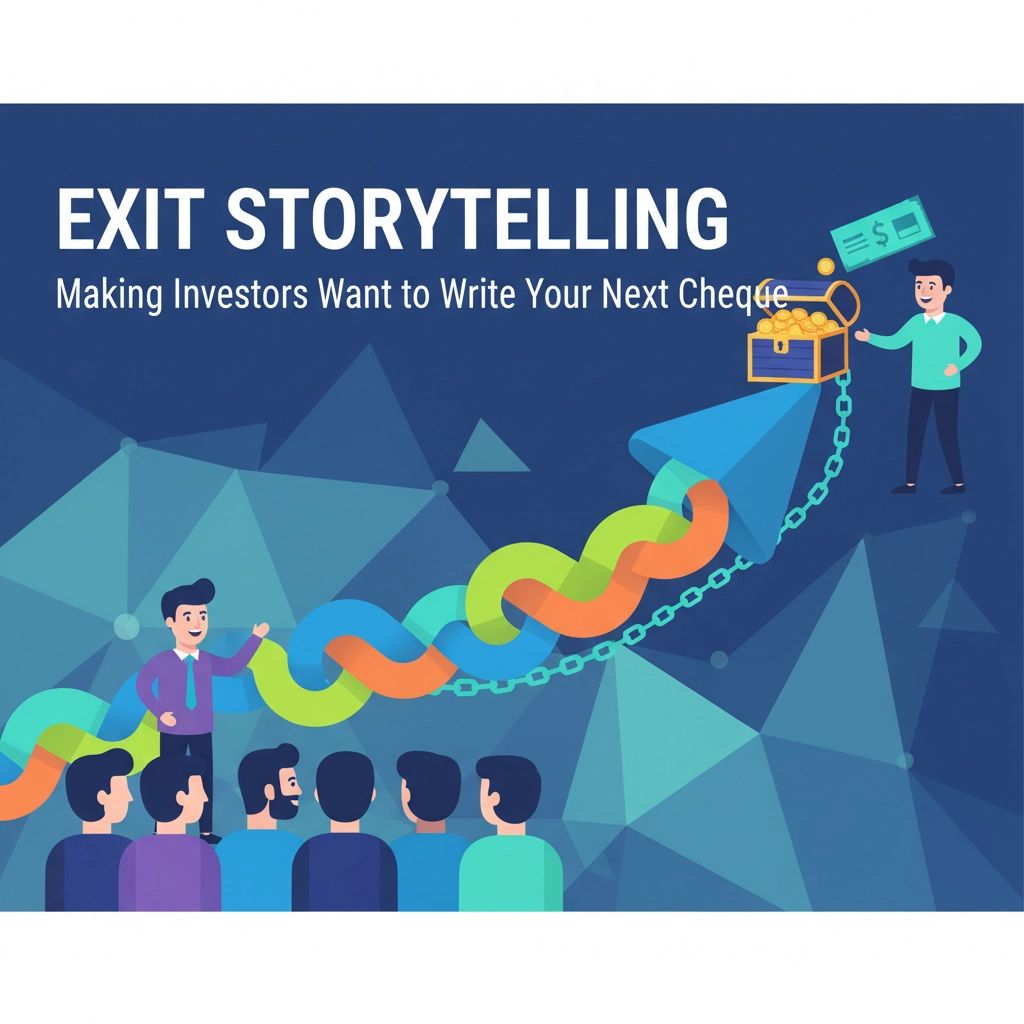Exit Storytelling: Making Investors Want to Write Your Next Cheque
Oct 02, 2025
Here's the brutal truth: 92% of deeptech and healthtech founders tell investors boring stories that kill deals before they even start.
You've got groundbreaking science, revolutionary technology, and the potential to transform entire industries. But when it comes to fundraising, you're still talking about your tech specs instead of your exit vision. Big mistake.
The founders who raise faster, get better terms, and have VCs fighting to write their next cheque? They've cracked the code on exit storytelling. They don't just pitch their product: they paint a picture of exactly how investors will make their money back. And they do it in a way that's so clear, so compelling, that even the janitor at the VC firm could explain why this deal is a winner.
Ready to become one of them? Let's go! 💥
Why Most Founder Stories Fall Flat (And Yours Might Too)
Here's what happens in 90% of seed and Series A pitches:
"We've developed a novel biomarker discovery platform using AI-driven genomic analysis that can identify therapeutic targets 10x faster than traditional methods..."
Stop. Right. There.
Your investors' eyes just glazed over. Not because your tech isn't incredible: it absolutely is. But because you just told them about your process instead of your promise. You talked about what you built, not where you're going.
The investors who write the biggest cheques aren't buying your current capabilities. They're buying your future exit story.

The Exit-First Storytelling Revolution
Here's what the smartest founders in deeptech and healthtech have figured out: Capital follows clarity. When you can clearly articulate exactly how and when you'll deliver returns, investors stop seeing you as a risk and start seeing you as an opportunity.
Think about it this way: Your Series A investor needs to show their LPs a 10x return within 5-7 years. If you can paint a crystal-clear picture of how that happens: complete with acquisition targets, market consolidation trends, and strategic buyer motivations: you become irresistible.
This isn't just theory. It's happening right now.
The deeptech companies that raised the fastest rounds in 2024 all had one thing in common: They didn't just have great technology. They had exit stories so compelling that investors couldn't stop talking about them.
The 3-Step Exit Messaging Framework That Wins Rounds
Ready to transform your fundraising story from "meh" to "must-have"? Here's the exact framework that's helping seed and Series A founders in deeptech and healthtech close rounds 3x faster:
Step 1: The Einstein Test - Make It Janitor-Simple
The Rule: If you can't explain your exit story to the janitor, you can't explain it to investors.
Einstein said if you can't explain it simply, you don't understand it well enough. The same applies to your exit narrative. Your story needs to be so clear that anyone: from the associate who first screens your deck to the GP who writes the cheque: can repeat it perfectly.
For Deeptech Founders:
Instead of: "Our quantum optimization algorithms solve NP-hard problems in logistics optimization..."
Try this: "We're the Google Maps for supply chain routing. Amazon will pay $2B to cut their shipping costs by 15%."
For Healthtech Founders:
Instead of: "Our digital therapeutics platform leverages behavioral psychology and machine learning to improve patient adherence..."
Try this: "We're the Peloton for chronic disease. Pfizer will acquire us to own the $50B patient engagement market."
Your Action Step: Write your exit story in exactly 30 words. If you can't, you're not ready to raise.
Step 2: The Strategic Buyer Map - Name Names
The Rule: Vague exit stories get vague investor interest. Specific exit stories get specific cheques.
Don't say "pharmaceutical companies will want to acquire us." Say "Roche acquired Flatiron Health for $1.9B to access cancer data. We have the exact same play in cardiology, and their head of BD already knows our CEO."
The Strategic Buyer Research Process:
- Identify 5-7 specific companies who would pay premium for your capabilities
- Find recent acquisitions these buyers made in adjacent markets
- Calculate acquisition multiples based on similar deals
- Map decision makers at each target acquirer
- Build connection pathways through your network, advisors, or investors

Pro Tip for Deeptech: Focus on enterprise buyers with massive cost savings opportunities. "Intel will pay $500M to cut chip design time by 6 months" hits different than "semiconductor companies need better tools."
Pro Tip for Healthtech: Target pharma companies with expiring patents or payers with rising costs. "UnitedHealth will pay $1B to reduce diabetes spending by 10%" creates urgency.
Step 3: The Inevitability Narrative - Why Now, Why You
The Rule: Great exit stories feel inevitable, not hopeful.
Your acquisition shouldn't feel like a nice-to-have opportunity. It should feel like a strategic imperative that's happening with or without you: but much better with you.
The Inevitability Framework:
- Market Force: What massive trend makes your solution inevitable?
- Competitive Pressure: Which competitors are forcing big players to act?
- Financial Imperative: What costs/revenues drive acquisition urgency?
- Timing Window: Why must they move in the next 12-24 months?
Example for AI/Deeptech:
"Google spent $2.6B on AI talent last year and still can't match OpenAI's capabilities. Our specialized AI chips give them a 3-year head start in the next AI race. They have 18 months before NVIDIA's next-gen chips level the playing field."
Example for Healthtech:
"CVS just committed $10B to transform healthcare delivery. They need our remote monitoring platform to compete with Amazon's push into healthcare. If they don't acquire a leader in the next 12 months, they'll be stuck building from scratch while Amazon captures market share."
Making Your Exit Story Investor-Irresistible
Here's where the magic happens. When you nail all three steps, something incredible occurs: Investors start selling for you.
They can't help but share your story with their partners. They bring you up in Monday morning meetings. They introduce you to other investors not as competition, but because your story is so compelling they want to be associated with it.
This is how oversubscribed rounds happen.

The Deeptech & Healthtech Exit Storytelling Playbook
For Deeptech Founders - The "Infrastructure Play"
Your exit story should position you as critical infrastructure for the future. Think:
- "We're the NVIDIA for quantum computing"
- "We're the MongoDB for edge computing"
- "We're the Stripe for autonomous vehicles"
The Template:
"[Big Tech Company] needs to win [Future Market]. They've spent $[Billions] but still can't [Specific Capability]. We solve this in 18 months vs. their 5-year timeline. Every month they wait costs them $[Market Share Loss]."
For Healthtech Founders - The "Economic Imperative Play"
Your exit story should make acquisition a financial no-brainer. Think:
- "We save [Payer] $500M annually in diabetes costs"
- "We help [Pharma] extend [Blockbuster Drug] lifecycle by 3 years"
- "We reduce [Health System] readmissions by 40%"
The Template:
"[Strategic Buyer] faces $[Cost Problem] growing 15% annually. Our solution delivers $[Savings] in year one, $[Bigger Savings] by year three. The acquisition pays for itself in [Timeframe], then generates $[Profit] annually."
Your Next Move: Turn Story Into Strategy
Congratulations! You now have the exact framework that's helping founders just like you close their next rounds 3x faster. But here's the thing: frameworks only work when you work them.
Here's what to do next:
✅ Write your 30-word exit story using the Einstein Test
✅ Map your top 5 strategic buyers with specific names and acquisition rationales
✅ Build your inevitability narrative with market forces and timing drivers
✅ Test your story with 3 trusted advisors this week
✅ Integrate your exit vision into your next investor conversation
The best part? When you nail your exit storytelling, fundraising becomes easier. Not because raising money is ever truly easy, but because investors finally understand exactly how they'll make money backing you.
That clarity is your competitive advantage. That story is your secret weapon.
Ready to make your next investor conversation the one that changes everything? Your exit story starts now. 🚀
Want help crafting your specific exit narrative? Our team at Capital Catalyst has helped 200+ deeptech and healthtech founders turn their technical brilliance into investor-irresistible exit stories. Learn more about our approach and join the founders who are raising faster, better, and with more confidence than ever before.
